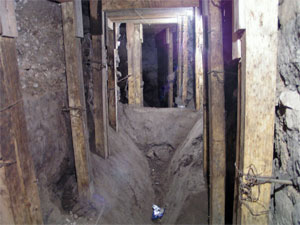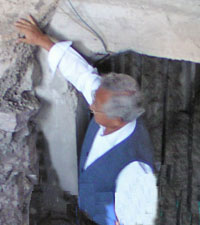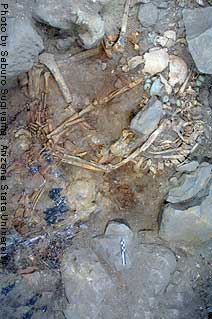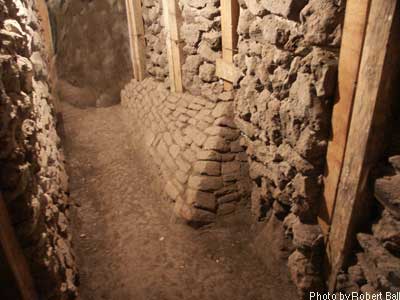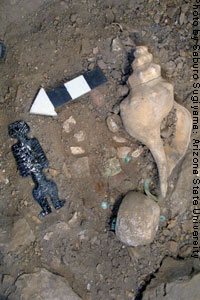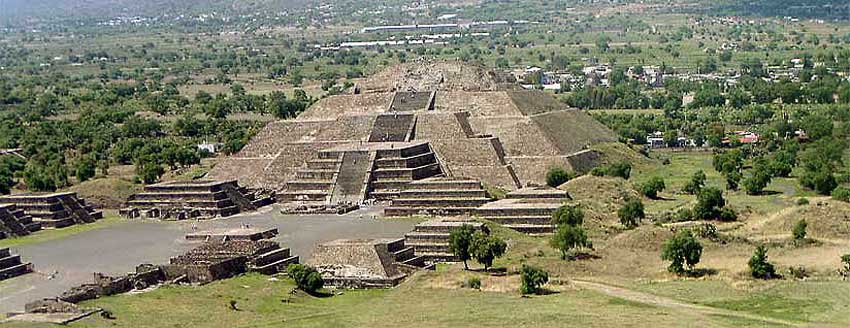Teotihuacan Pyramid of the Moon and Pyramid of the Sun |
We looked at this picture when we stood on the approximate crossing of the Street of the Dead and the East-West Street before entering the Ciudadela. It's worth a second look upon leaving the precincts of the Feathered Serpent Pyramid not so much, this time, for the walls that break up easy passage through the "Street," but for what lies at the very end—the Pyramid of the Moon and behind it the mountain, Cerro Gordo. It is no happenstance that the pyramid and the mountain are seen in juxtaposition from the vantage point of the Street of the Dead. The idea that a pyramid is a sacred mountain was widespread throughout Mesoamerica. Here, in one of its most ancient and most influential cities, the symbolism was made explicit. Standing before the mountain, the Pyramid of the Moon becomes the icon that anchors Teotihuacan's city plan. To walk from the Ciudadela past the Pyramid of the Sun to the Pyramid of the Moon is not only to walk a couple of miles in space but also to travel back in time. Both of these pyramids, each of which underwent several construction periods, were completed by 200 CE, at a time when construction had just begun on the Feathered Serpent Pyramid. |
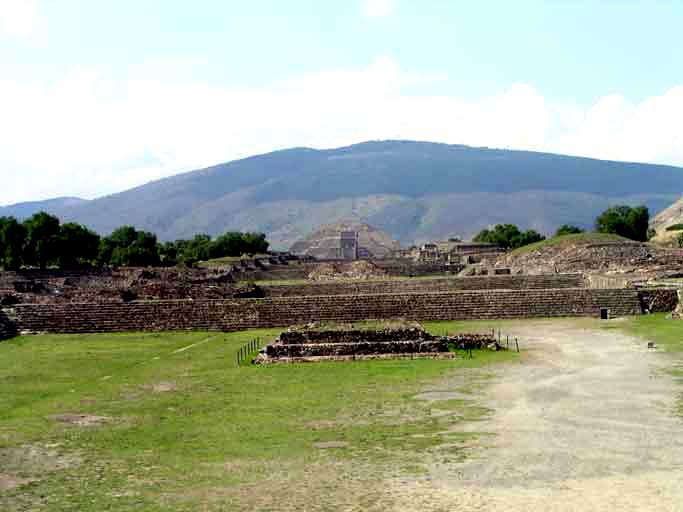 |
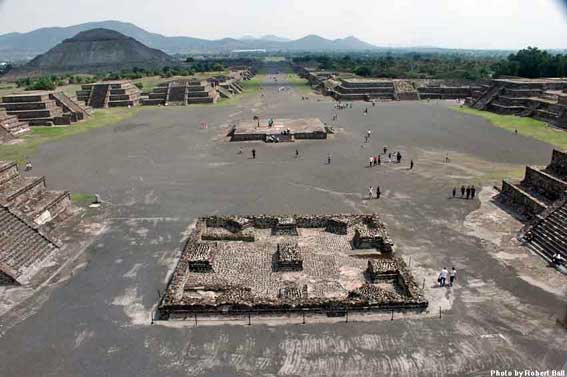 |
From the top of the Pyramid of the Moon today's visitor is able to imagine what an ancient priest or king would have seen on a great festive occasion as he looked out over Teotihuacan's religious and civic center from the Moon Temple. Before him was the Moon Plaza, a communal and/or ceremonial gathering place, comparable in function perhaps to the Ciudadela, that would have been crowded with people. In the distance to the south stretched the Street of the Dead, lined with palaces and temples, down which a festival parade approached. To his left, on the east, was the immense Pyramid of the Sun, crowned with its own splendid temple. Might the priest have waved to his counterpart over there, as tourists do today? It would not have escaped his notice that the Sun Pyramid was shadowed by a mountain of its own. Everything he saw before him confirmed the power of the city, of its people, and especially of its leadership. |
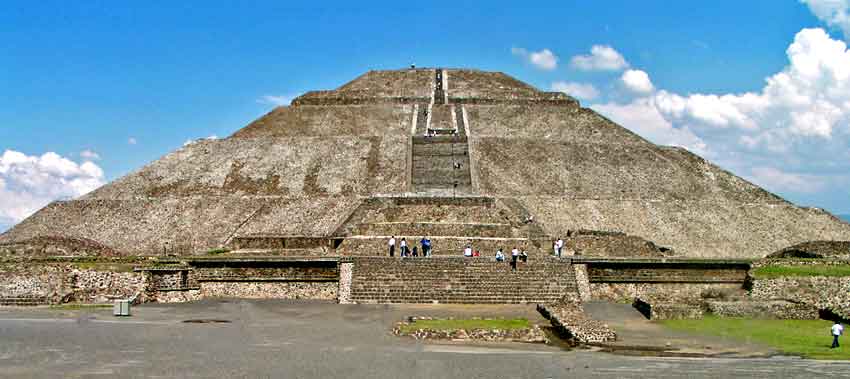 |
PYRAMID OF THE SUN
The Pyramid of the Sun, which looms over the city, was built in stages over a period of time in the second century of the common era. Originally it consisted of four stepped platforms (a fifth was mistakenly "reconstructed" when archaeologists began work at Teotihuacan in the early 20th century). Now about 200 feet in height with a footprint of almost half a million square feet, it is the third largest pyramid in the world (after those of Khufu and Khafra in Egypt). The casual visitor sees this huge structure, with a stairway to the top that begs to be climbed, and doesn't wonder about what's inside. Well, what's inside the Pyramid of the Sun is some 41 million cubic feet of mostly rubble. It is a big pile of mud brick, rocks, and junk. (The same is true of the Feathered Serpent Pyramid, which is why looters and archaeologists could tunnel into it.) But that's not everything inside this pyramid. There's a cave in there, a natural cave that was so important to the Teotihuacanos that they built a pyramid over it. The cave, which was enlarged and modified to serve ritual purposes long before the construction of the pyramid, now runs, 20 feet below the pyramid, for 330 feet from the stairway on the west, eastward toward the center. At its end is a room shaped rather like a four-leaf clover. Caves were important to the Aztecs and other Mesoamerican peoples as the places where new worlds emerged, where sun and moon were created. Though the Aztecs probably knew less about the Teotihuacanos than we do, they certainly knew the function of the Sun Pyramid's cave. It was where the gods created the Fifth World. It was Teotihuacan! No one knows if the Teotihuacanos thought of it that way but, for whatever reason, the cave was important enough to be glorified with the most massive pyramid in the Western Hemisphere. In fact, that cave may be the very reason the city was located where it was located. Pretty important cave, that. As it turns out, the old cave is pretty important for scientists in the 21st century, too. Mexican physicists have set up a sophisticated particle detecting device in there to track the passage of muons through the pyramid. Muons are sub-atomic particles that are left over after cosmic rays hit molecules in the earth's atmosphere. These super-tiny muons travel just short of the speed of light and pass through solid objects. However, some of them get absorbed by the mass of the pyramid and some pass on through. If, then, the detector detects a spot in the pyramid with lots of muons it means they weren't absorbed and are in what might be a empty spot,i.e., a tomb (maybe). Stay tuned. |
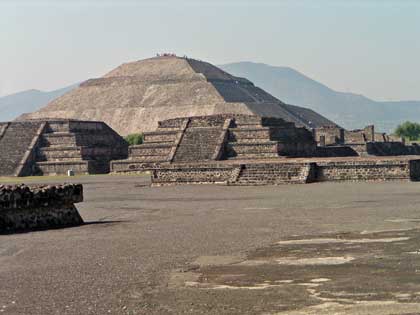 |
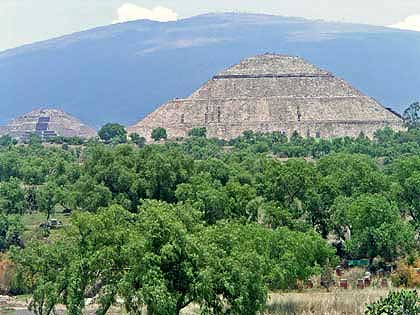 |
The Pyramid of the Sun from the Pyramid of the Moon's base |
The Pyramid of the Sun (Moon in the background) from the Ciudadela |

